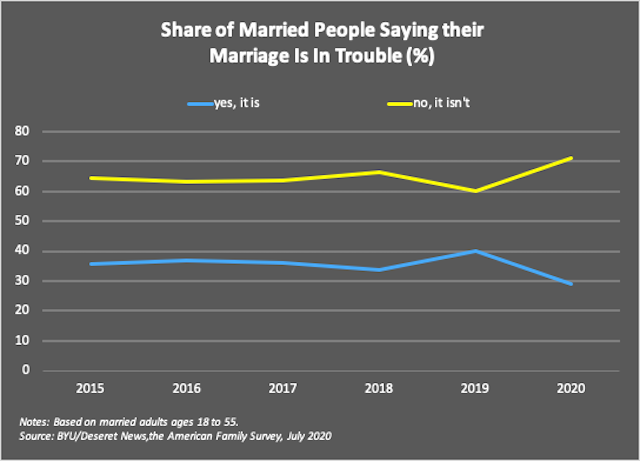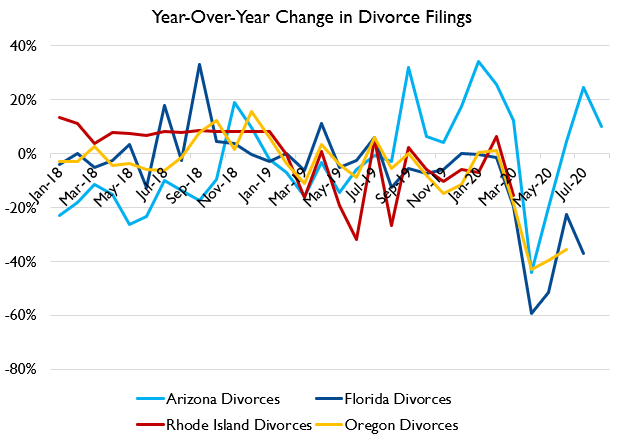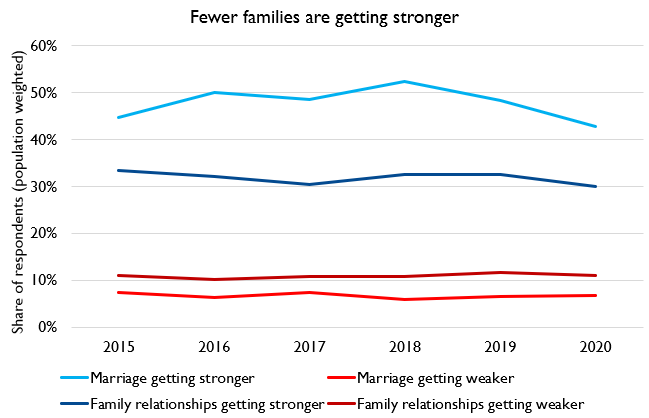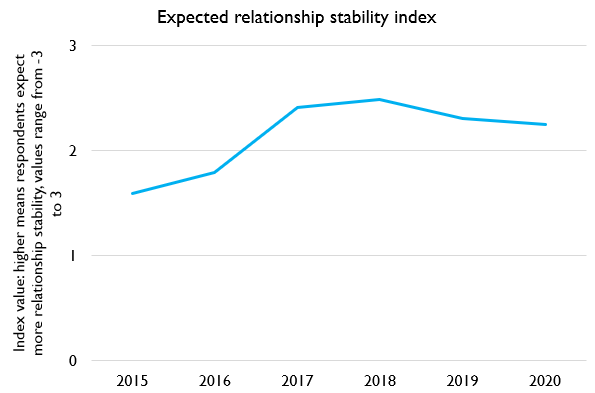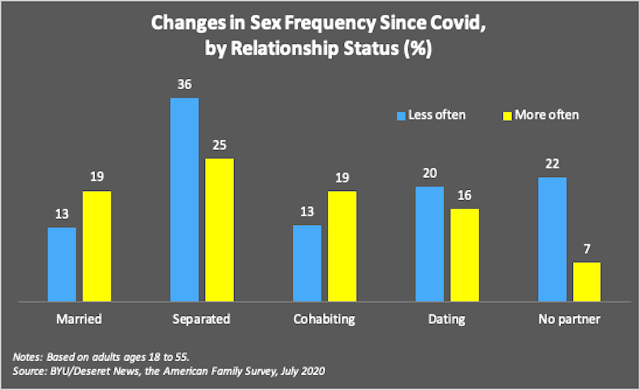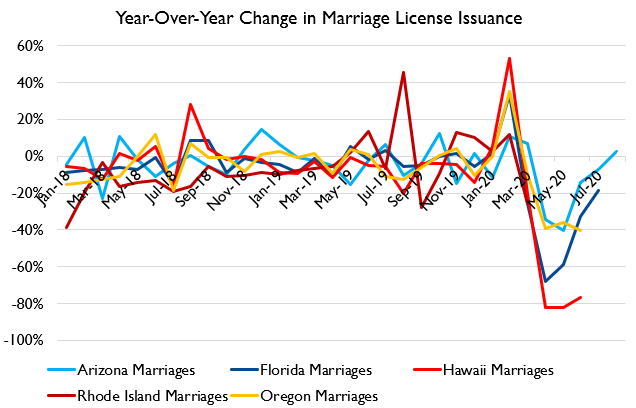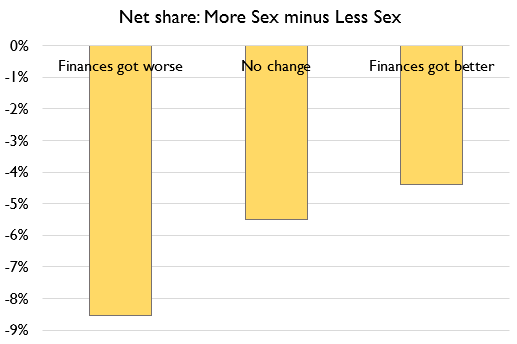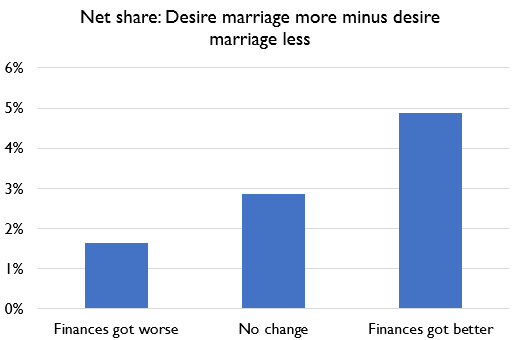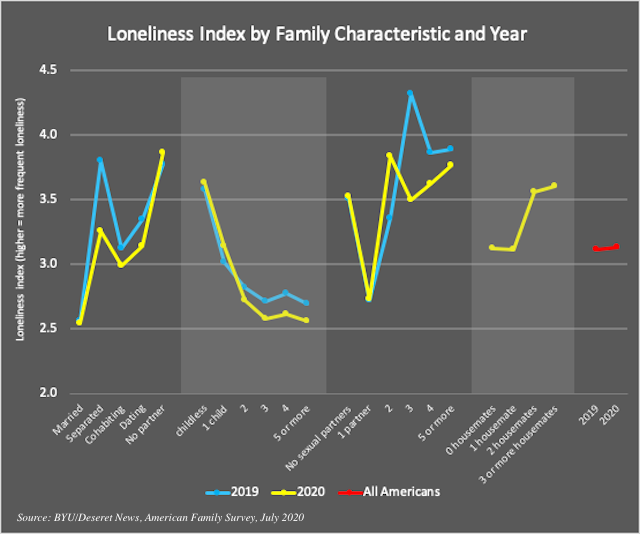I& #39;m at @FamStudies today with @WilcoxNMP and @WendyRWang reviewing how COVID-19 has impacted families using both high-frequency vital stats data and the newly-released American Family Survey. https://ifstudies.org/blog/the-good-and-bad-news-about-marriage-in-the-time-of-covid">https://ifstudies.org/blog/the-...
Our findings are.... mixed. By some measures, family life has gotten stronger. By others, it& #39;s gotten weaker. So, for example, the share who say their marriage is "in trouble" has fallen to historic lows. That& #39;s good news!
In general, whenever the AFS asked people about how COVID impacted their relationships, or whenever it asked them questions about what might be called "negative affect," we get good responses: COVID made me appreciate my partner more! COVID didn& #39;t add too much stress!
People gave really strong responses communicating that they do *not* explicitly perceive their marriages and families to be in trouble. So we might say "explicit self-perceived marital and relationship quality is UP."
And this good news can be backed up in administrative data too. All those stores about a "spike in divorce" were completely wrong. For the four states that have reported data, divorces fell by a lot, and even post-lockdown there& #39;s no huge spike.
But there& #39;s bad news too. If instead of asking people "Has COVID made your marriage stronger?" we just ask people to rate their marital strength and compare it to previous years, how does it stack up?
We can look deeper too: there& #39;s a longstanding question asking people in a relationship, "Do you expect to be in this relationship 2 years from now?" They give a variety of responses weighing the odds, but we can make an index of those answers.
We can also look at sex. Three questions ask about sex: one asks married people to estimate their sexual frequency, one asks all people their number of sexual partners, and one asked if people& #39;s sexual frequency had changed since March.
On married sexual frequency, there was little change or maybe a slight decline depending on how you measure it. On number of sexual partners, there was a considerable decline, especially among the non-married (i.e. less sexual coupling is occurring).
But the graph I like best is this one: married and cohabiting people perceive their sexual frequency to have risen. But look at that change for singles!
Those not locked down WITH someone have experienced a significant decline in sexual frequency. Pandating means not dating.
And there& #39;s bad news in administrative data too. Marriage license issuance fell dramatically and there& #39;s no sign yet of catch-up above-trend marriages. That& #39;s a serious postponement effect!
The big February spike by the way is driven mostly by marriages on February 29th. For the one state that has daily data, February 29th is BY FAR the biggest day for weddings in 2020 thus far. It& #39;s possible some "early shift" in marriage occurred among people worried about COVID.
But there& #39;s important heterogeneity too. My favorite way to break out people is people who said their financial situation got better/worse since March.
So, who& #39;s having less sex? People whose financial situation got worse.
So, who& #39;s having less sex? People whose financial situation got worse.
On net, people report COVID increasing their desire to get married: but there& #39;s a big difference by changing financial status.
When we get more concrete and ask people about *actual marriage plans* things turn more negative for all groups, but still financial-improvers report a rosier outlook.
We can also look at how COVID has changed things (bars are worse/stable/improve): in general COVID& #39;s impact on relationships has been a lot worse for those with worsening finances.
I could go on. Pregnancy plans. Closeness to extended family. Take your pick. In many cases the signs are even flipped: there have been radical differences in COVID& #39;s impact on family by how their economic circumstances have changed.
On net, my read of the situation is 1) families are facing real strains testing their ties, as evinced by the YoY change data, 2) but families are determined to make lemons of lemonade and are trying to double down on their relationships in tough times...
3) but families facing major economic losses in addition to the disruptions of the pandemic are having a harder time doing this
Yesterday I had a piece at @FamStudies writing about how COVID is impacting family strength. Today I have a piece about how COVID, and family life during COVID, impacts LONELINESS. https://ifstudies.org/blog/loneliness-during-the-covid-19-pandemic">https://ifstudies.org/blog/lone...
I once again use data from the new American Family Survey. They ask three questions about loneliness: how often people feel left out, isolated, or lacking companionship.
I sum these on a 0-2 index. People who "hardly ever" feel a specific kind of loneliness score a 0 for it. Those who "sometimes" do score a 1, and those who "often" do score a 2. Summed up, that creates a 0-6 index of loneliness for each respondent.
And it turns out, a lot of loneliness can be explained by family structure. Married people and people with lots of kids are the least lonely. People with precisely 1 sex partner in the prior 2 years are the least lonely. People with fewer non-family housemates are less lonely.
These relationships are all robust to controlling for each other, and to adding controls for race, education, self-reported change in financial situation since March.
The self-reported change in financial situation since March helps illuminate why I think these relationships are at least a little bit causal. It& #39;s implausible that predisposition to loneliness caused a big financial loss March-July since we know what caused loss was COVID.
Likewise, the supposed relationship fraught loneliness to marital status is a bit fraught: maybe lonely people are less marriagable.... but also people who never get lonely when single may not feel much appeal to married life!
Same for children: maybe lonely people have a hard time coupling to have kids.... but also lonely people might be more likely to have kids, i.e. to create people to be around them!
At least some of these things definitely run from the independent to the dependent variable at least sometimes in a causal way. And since we also see that people with lots of sex partners or housemates are lonelier, it really suggests "lonely people seek partnership"...
Which would imply that the causal effect of marriage and kids may be EVEN LARGER than what& #39;s shown here, if people predisposed to loneliness disproportionately seek out companionship opportunities.
There& #39;s also the change from 2019 to 2020 that& #39;s worth considering. In aggregate, SHOCKINGLY, people in 2020 reported almost the identical amount of loneliness as in 2019.
There is in fact not evidence from year-over-year survey data that loneliness rose in 2020.
There is in fact not evidence from year-over-year survey data that loneliness rose in 2020.
But what we do see is a change in WHO was lonely.
The gap between people with romantic partners and people without them grew. The gap between people with kids and people without them grew.
The gap between people with romantic partners and people without them grew. The gap between people with kids and people without them grew.
It& #39;s a modest change, but it& #39;s actually what we& #39;d expect: lockdowns massively INCREASED the hedonic benefits to family. Far from "families going crazy," the people going crazy are single people quarantined alone.
Families are stressed, yes. But they also report newfound appreciation for their family, tightening social bonds, and other real hedonic benefits. This is consistent with the anti-loneliness effect of family intensifying in 2020 vs. 2019.

 Read on Twitter
Read on Twitter